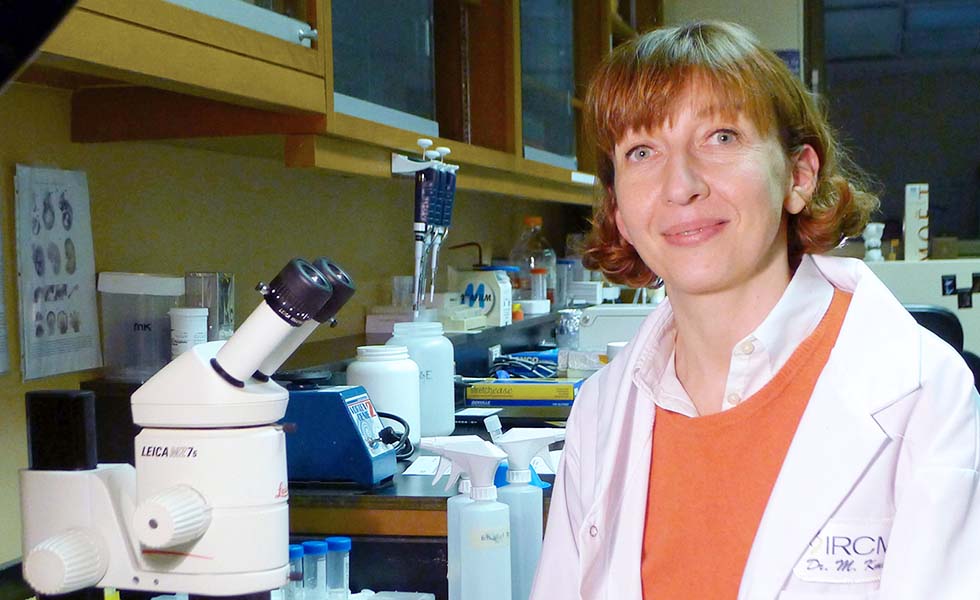
The research team of Marie Kmita, Director of the IRCM Genetics and Development research unit, has identified two genes responsible for the switch between two genetic programs controlling limb development. This discovery has made the cover of Cell Reports.
Two genes directing a network
Limb development occurs progressively, from the part closest to the body to the part furthest away. The arm starts to develop first, then the forearm, wrist and fingers. This progression reflects the sequential activity of two genetic programs: the early phase and late phase.
The switch from the early to the late phase is characterized by changes in the activity of several genes: some previously inactivated genes become activated, and vice versa. How does this happen? What triggers the switch controlling gene activity to transition to the next phase when appropriate? Two genes: Hoxa13 and Hoxd13.
“Without Hoxa13 and Hoxd13, the activity of the early phase is maintained: the switch from this phase—responsible for the development of the part of the limb closest to the body—to the late phase doesn’t seem to occur and the hand doesn’t form,” explains Rushikesh Sheth, lead author of the paper. A former postdoctoral researcher in Dr. Kmita’s laboratory, Dr. Sheth is now a senior researcher at the University of Basel.
To come to this conclusion, the IRCM team mapped the differences in the activity of the genome in the early and late phases. Specifically, the team identified a network of several thousand regulatory regions whose function varies depending on the phase in question, thus affecting the activity of a whole series of genes.
“Our results show a much broader impact than initially expected,” explains Dr. Kmita. “Hoxa13 and Hoxd13 do more than just influence the activity of two or three other genes. They have an exponential effect on several thousand switches, directing the activity of a whole network of genes. Hoxa13 and Hoxd13 act a bit like orchestra conductors.”
About the study
The research project was conducted at the IRCM Genetics and Development research unit by Rushikesh Sheth and Marie Kmita, as well as Stephen Nemec and Jacques Drouin of the Molecular Genetics research unit. Iros Barozzi, Marco Osterwalder and Axel Visel of the Lawrence Berkeley National Laboratory, David Langlais of McGill University and Hanqian L. Carlson and H. Scott Stadler of Shriners Hospitals for Children also collaborated on the research. The study was funded by the Canada Research Chairs Program, Canadian Institutes of Health Research, National Institutes of Health, Fonds de recherche du Québec–Santé [Quebec health research fund] and Swiss National Science Foundation.
About the IRCM
Founded in 1967, the Institut de recherches cliniques de Montréal (IRCM) / Montreal Clinical Research Institute is a non-profit organization that conducts fundamental and clinical biomedical research in addition to training high-level young scientists. With its cutting-edge technology facilities, the institute brings together 33 research teams, which work in cancer, immunology, neuroscience, cardiovascular and metabolic diseases, systems biology and medicinal chemistry. The IRCM also operates a research clinic specialized in hypertension, cholesterol, diabetes and cystic fibrosis, as well as a research centre on rare and genetic diseases in adults. The IRCM is affiliated with the Université de Montréal and associated with McGill University. Its clinic is affiliated with the Centre hospitalier de l’Université de Montréal (CHUM). The IRCM is supported by the Ministère de l’Économie, de la Science et de l’Innovation (Quebec ministry of Economy, Science and Innovation).
Source:
Anne-Marie Beauregard, Communications Officer
Institut de recherches cliniques de Montréal (IRCM) / Montreal Clinical Research Institute
514 987-5555 | anne-marie.beauregard@ircm.qc.ca




